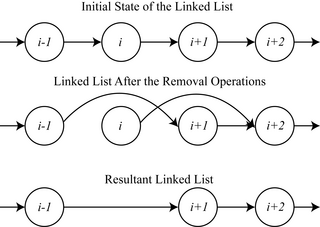Related Research Articles

Ada is a structured, statically typed, imperative, and object-oriented high-level programming language, extended from Pascal and other languages. It has built-in language support for design by contract (DbC), extremely strong typing, explicit concurrency, tasks, synchronous message passing, protected objects, and non-determinism. Ada improves code safety and maintainability by using the compiler to find errors in favor of runtime errors. Ada is an international technical standard, jointly defined by the International Organization for Standardization (ISO), and the International Electrotechnical Commission (IEC). As of 2020, the standard, called Ada 2012 informally, is ISO/IEC 8652:2012.

In computer science, garbage collection (GC) is a form of automatic memory management. The garbage collector attempts to reclaim memory which was allocated by the program, but is no longer referenced; such memory is called garbage. Garbage collection was invented by American computer scientist John McCarthy around 1959 to simplify manual memory management in Lisp.

In computer science, mutual exclusion is a property of concurrency control, which is instituted for the purpose of preventing race conditions. It is the requirement that one thread of execution never enters a critical section while a concurrent thread of execution is already accessing said critical section, which refers to an interval of time during which a thread of execution accesses a shared resource or shared memory.
In computing, scheduling is the action of assigning resources to perform tasks. The resources may be processors, network links or expansion cards. The tasks may be threads, processes or data flows.
In computer science, a lock or mutex is a synchronization primitive: a mechanism that enforces limits on access to a resource when there are many threads of execution. A lock is designed to enforce a mutual exclusion concurrency control policy, and with a variety of possible methods there exists multiple unique implementations for different applications.
In computer science, priority inversion is a scenario in scheduling in which a high priority task is indirectly superseded by a lower priority task effectively inverting the assigned priorities of the tasks. This violates the priority model that high-priority tasks can only be prevented from running by higher-priority tasks. Inversion occurs when there is a resource contention with a low-priority task that is then preempted by a medium-priority task.
In computer science, an algorithm is called non-blocking if failure or suspension of any thread cannot cause failure or suspension of another thread; for some operations, these algorithms provide a useful alternative to traditional blocking implementations. A non-blocking algorithm is lock-free if there is guaranteed system-wide progress, and wait-free if there is also guaranteed per-thread progress. "Non-blocking" was used as a synonym for "lock-free" in the literature until the introduction of obstruction-freedom in 2003.
The MCP is the operating system of the Burroughs small, medium and large systems, including the Unisys Clearpath/MCP systems.
In real-time computing, the priority ceiling protocol is a synchronization protocol for shared resources to avoid unbounded priority inversion and mutual deadlock due to wrong nesting of critical sections. In this protocol each resource is assigned a priority ceiling, which is a priority equal to the highest priority of any task which may lock the resource. The protocol works by temporarily raising the priorities of tasks in certain situations, thus it requires a scheduler that supports dynamic priority scheduling.
Professor Alan Burns FREng FIET FBCS FIEEE CEng is a professor in the Computer Science Department at the University of York, England. He has been at the University of York since 1990, and held the post of Head of Department from 1999 until 30 June 2006, when he was succeeded by John McDermid.

The Ada Semantic Interface Specification (ASIS) is a layered, open architecture providing vendor-independent access to the Ada Library Environment. It allows for the static analysis of Ada programs and libraries. It is an open, published interface library that consists of the Ada environment and their tools and applications.

FreeRTOS is a real-time operating system kernel for embedded devices that has been ported to 35 microcontroller platforms. It is distributed under the MIT License.
In software engineering, profiling is a form of dynamic program analysis that measures, for example, the space (memory) or time complexity of a program, the usage of particular instructions, or the frequency and duration of function calls. Most commonly, profiling information serves to aid program optimization, and more specifically, performance engineering.
Uniform machine scheduling is an optimization problem in computer science and operations research. It is a variant of optimal job scheduling. We are given n jobs J1, J2, ..., Jn of varying processing times, which need to be scheduled on m different machines. The goal is to minimize the makespan - the total time required to execute the schedule. The time that machine i needs in order to process job j is denoted by pi,j. In the general case, the times pi,j are unrelated, and any matrix of positive processing times is possible. In the specific variant called uniform machine scheduling, some machines are uniformly faster than others. This means that, for each machine i, there is a speed factor si, and the run-time of job j on machine i is pi,j = pj / si.
Thread Level Speculation (TLS), also known as Speculative Multithreading, or Speculative Parallelization, is a technique to speculatively execute a section of computer code that is anticipated to be executed later in parallel with the normal execution on a separate independent thread. Such a speculative thread may need to make assumptions about the values of input variables. If these prove to be invalid, then the portions of the speculative thread that rely on these input variables will need to be discarded and squashed. If the assumptions are correct the program can complete in a shorter time provided the thread was able to be scheduled efficiently.
Loop-level parallelism is a form of parallelism in software programming that is concerned with extracting parallel tasks from loops. The opportunity for loop-level parallelism often arises in computing programs where data is stored in random access data structures. Where a sequential program will iterate over the data structure and operate on indices one at a time, a program exploiting loop-level parallelism will use multiple threads or processes which operate on some or all of the indices at the same time. Such parallelism provides a speedup to overall execution time of the program, typically in line with Amdahl's law.
DDC-I, Inc. is a privately held company providing software development of real-time operating systems, software development tools, and software services for safety-critical embedded applications, headquartered in Phoenix, Arizona. It was first created in 1985 as the Danish firm DDC International A/S, a commercial outgrowth of Dansk Datamatik Center, a Danish software research and development organization of the 1980s. The American subsidiary was created in 1986. For many years, the firm specialized in language compilers for the programming language Ada.
Tracing just-in-time compilation is a technique used by virtual machines to optimize the execution of a program at runtime. This is done by recording a linear sequence of frequently executed operations, compiling them to native machine code and executing them. This is opposed to traditional just-in-time (JIT) compilers that work on a per-method basis.
The term scheduling analysis in real-time computing includes the analysis and testing of the scheduler system and the algorithms used in real-time applications. In computer science, real-time scheduling analysis is the evaluation, testing and verification of the scheduling system and the algorithms used in real-time operations. For critical operations, a real-time system must be tested and verified for performance.
Runtime predictive analysis is a runtime verification technique in computer science for detecting property violations in program executions inferred from an observed execution. An important class of predictive analysis methods has been developed for detecting concurrency errors in concurrent programs, where a runtime monitor is used to predict errors which did not happen in the observed run, but can happen in an alternative execution of the same program. The predictive capability comes from the fact that the analysis is performed on an abstract model extracted online from the observed execution, which admits a class of executions beyond the observed one.
References
- Alan Burns (December 1999). "The Ravenscar Profile" (PDF). ACM SIGAda Ada Letters . XIX (4): 49–52. doi:10.1145/340396.340450. S2CID 29367277.
- Alan Burns, Brian Dobbing and Tullio Vardanega (June 2004). "Guide for the use of the Ada Ravenscar Profile in high integrity systems" (PDF). ACM SIGAda Ada Letters. XXIV (2): 1–74. doi:10.1145/997119.997120. S2CID 36061649.
- Ravenscar profile for high-integrity systems (Technical report). ISO/WG9 Ada Rapporteur Group. AI95-00249.